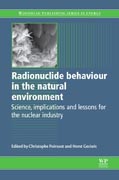
Radionuclide behaviour in the natural environment: science, implications and lessons for the nuclear industry
Poinssot, C.
Geckeis, H.
Understanding radionuclide behaviour in the natural environment is essential to the sustainable development of the nuclear industry and key to assessing potential environmental risks reliably. Minimising those risks is essential to enhancing public confidence in nuclear technology. Scientific knowledge in thisfield has developed greatly over the last decade. Radionuclide behaviour in the natural environment: Science, impacts and lessons for the nuclear industry provides a comprehensive overview of the key processes and parameters affecting radionuclide mobility and migration. After an introductory chapter, part oneexplores radionuclide chemistry in the natural environment, including aquaticchemistry and the impact of natural organic matter and microorganisms. Part two discusses the migration and radioecological behavior of radionuclides. Topics include hydrogeology, sorption and colloidal reactions as well as in-situ investigations. Principles of modelling coupled geochemical, transport and radioecological properties are also discussed. Part three covers application issues: assessment of radionuclide behaviour in contaminated sites, taking Chernobyl as an example, estimation of radiological exposure to the population, performance assessment considerations related to deep geological repositories, and remediation concepts for contaminated sites. INDICE: Overview of radionuclide behaviour in the natural environment. Part 1 Radionuclide chemistry in the natural environment: Fundamentals of aquaticchemistry relevant to radionuclide behaviour in the environment; Aquatic chemistry of the actinides: aspects relevant to their environmental behavior; Aquatic chemistry of long-lived mobile fission and activation products in the context of deep geological disposal; Impacts of humic substances on the geochemical behaviour of radionuclides; Impacts of microorganisms on radionuclides in contaminated environments and waste materials. Part 2 Radionuclide migration: Hydrogeological features relevant to radionuclide migration in the natural environment; Radionuclide retention at solid/liquid interfaces in the natural environment; Radionuclide migration: coupling transport and chemistry; Impact of colloidal transport on radionuclide migration in the natural environment; Natural analogues of nuclear waste repositories: studies and their implications for the development of radionuclide migration models; Studying radionuclide migration on different scales: the complimentary roles of laboratory and in situ experiments; Radionuclide transfer processes in the biosphere. Part 3 Environmental impact and remediation: Modelling radionuclide transport in the environmentand calculating radiation doses; Quantitative assessment of radionuclide migration from near-surface radioactive waste burial sites: the waste dumps in theChernobyl exclusion zone as an example; Remediation of sites contaminated by radionuclides; Safety assessment of nuclear waste repositories: A radionuclidemigration perspective.
- ISBN: 978-0-85709-132-1
- Editorial: Woodhead
- Encuadernacion: Cartoné
- Páginas: 696
- Fecha Publicación: 01/09/2012
- Nº Volúmenes: 1
- Idioma: Inglés
